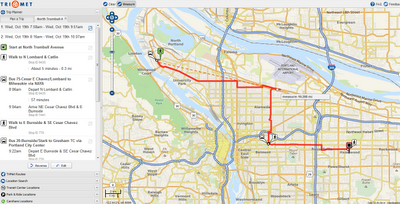Multi-modal Trip Planner OSM - Portland
Multi-modal trip planners can create routes that mix different modes of
travel. Not only can users plan a transit-only trip or a bike-only trip,
they can also plan a mixed mode trip—like biking to the train and then
continuing by train to their destinations.
Portland Regional Trip Planner
The new Portland Regional Trip Planner is a multi-modal trip planner funded by a pair of Metro Regional Travel Options Grants (2009-11 and 2011-13). October 15, 2011 is the formal launch date for TriMet’s beta release of the new trip planner and marks the first official deployment of a fully open source / open data trip planner by a major U.S. transit agency. RTP will replace TriMet’s transit-only trip planner after the beta test period of 3-6 months.
The technology behind RTP is called OpenTripPlanner. OpenTripPlanner’s worldwide developer community and broad user base has many advantages. As OpenTripPlanner improves, the Regional Trip Planner will improve. For more information about OpenTripPlanner, visit
https://github.com/openplans/OpenTripPlanner/wiki/.
FUTURE DEVELOPMENT (upcoming features)
These are some of the new exciting new features worked on due in a couple of weeks:
Printer-friendly itineraries and maps
Aerial imagery in the background (as a base map)
Trips involving multiple transit agencies
Elevation display for pedestrian trips
Ability to modify biking trips by dragging the route on the map
One-click switch between modes of travel for planned trips
Incorporating real-time transit information instead of schedules
Improved pedestrian routing using safety and accessibility data
Driving directions to transit centers and park-and-ride facilities
Try the Trip Planner Map











